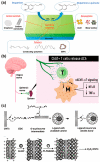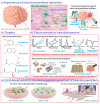An Updated Review on Electrochemical Nanobiosensors for Neurotransmitter Detection
- PMID: 37754127
- PMCID: PMC10526534
- DOI: 10.3390/bios13090892
An Updated Review on Electrochemical Nanobiosensors for Neurotransmitter Detection
Abstract
Neurotransmitters are chemical compounds released by nerve cells, including neurons, astrocytes, and oligodendrocytes, that play an essential role in the transmission of signals in living organisms, particularly in the central nervous system, and they also perform roles in realizing the function and maintaining the state of each organ in the body. The dysregulation of neurotransmitters can cause neurological disorders. This highlights the significance of precise neurotransmitter monitoring to allow early diagnosis and treatment. This review provides a complete multidisciplinary examination of electrochemical biosensors integrating nanomaterials and nanotechnologies in order to achieve the accurate detection and monitoring of neurotransmitters. We introduce extensively researched neurotransmitters and their respective functions in biological beings. Subsequently, electrochemical biosensors are classified based on methodologies employed for direct detection, encompassing the recently documented cell-based electrochemical monitoring systems. These methods involve the detection of neurotransmitters in neuronal cells in vitro, the identification of neurotransmitters emitted by stem cells, and the in vivo monitoring of neurotransmitters. The incorporation of nanomaterials and nanotechnologies into electrochemical biosensors has the potential to assist in the timely detection and management of neurological disorders. This study provides significant insights for researchers and clinicians regarding precise neurotransmitter monitoring and its implications regarding numerous biological applications.
Keywords: electrochemistry; nanobiosensors; nanomaterials; neurological diseases; neurotransmitter.
Conflict of interest statement
The authors declare no conflict of interest.
Figures





References
-
- Hornykiewicz O. Brain neurotransmitter changes in Parkinson’s disease. In: Marsden C.D., Fahn S., editors. Movement Disorders. Butterworth-Heinemann; Oxford, UK: 1981. pp. 41–58.
Publication types
Grants and funding
LinkOut - more resources
Full Text Sources

